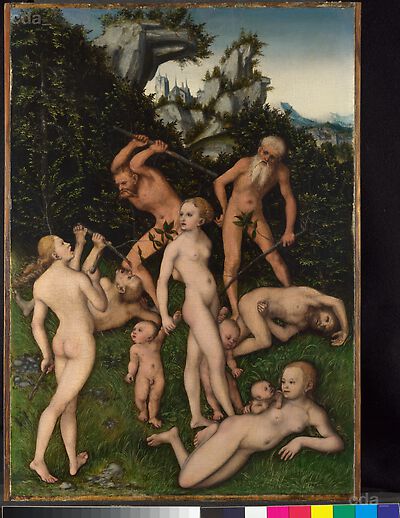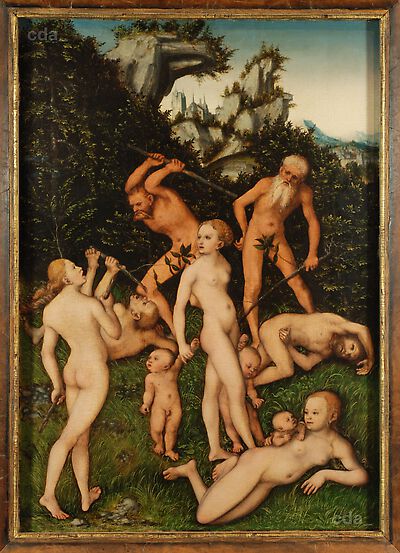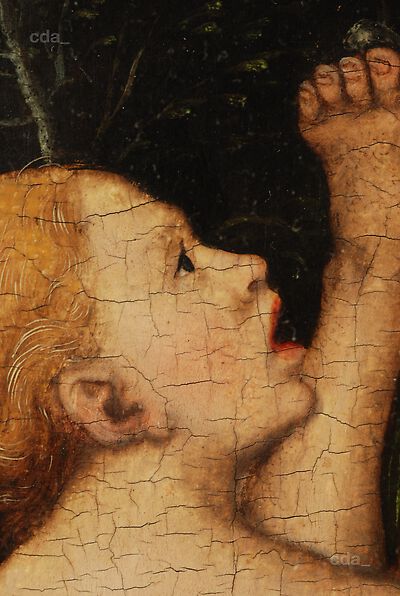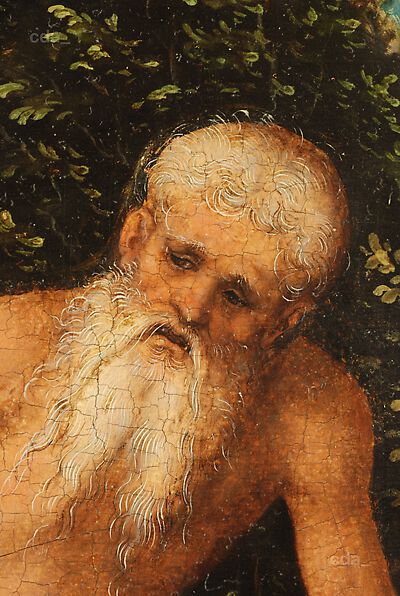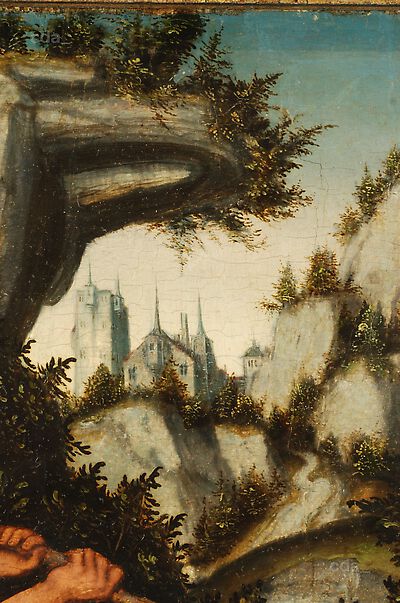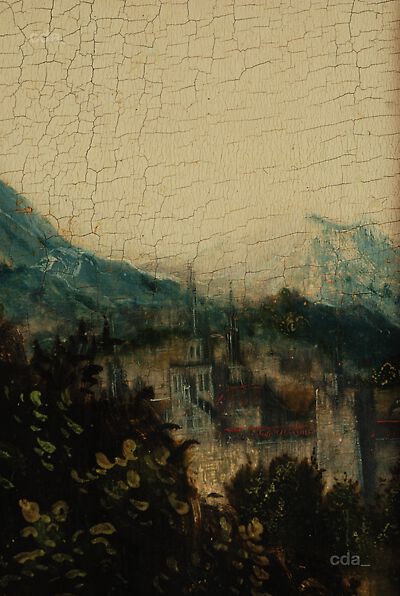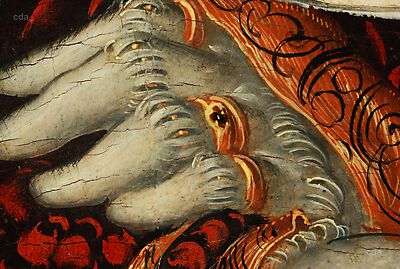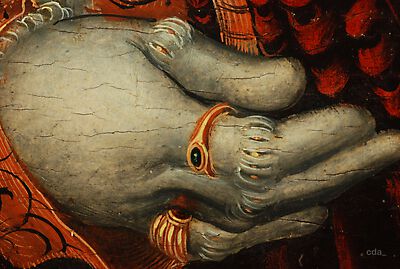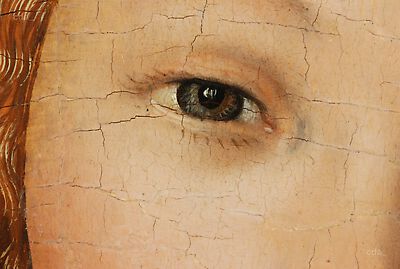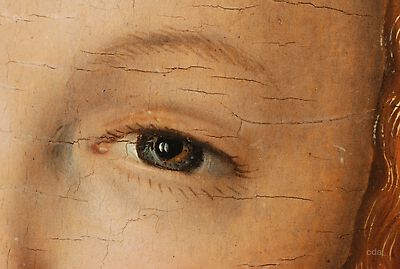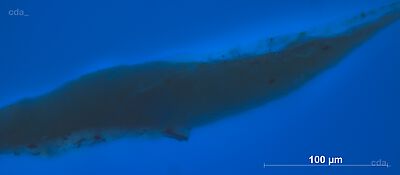| Exhib. Cat. Düsseldorf 2017 |
234 |
No. 134 |
|
| Editor | Gunnar Heydenreich, Daniel Görres, Beat Wismer |
|---|
| Title | Lucas Cranach der Ältere. Meister - Marke - Moderne. [anlässlich der Ausstellung "Cranach. Meister - Marke - Moderne", Stiftung Museum Kunstpalast, Düsseldorf, 08. April 2017 - 30. Juli 2017] |
|---|
| Place of Publication | Munich |
|---|
| Year of Publication | 2017 |
|---|
|
| Exhib. Cat. Gotha, Kassel 2015 |
208 |
|
|
| Editor | Julia Carrasco, Justus Lange, Benjamin D. Spira, Timo Trümper, Stiftung Schloss Friedenstein, Gotha |
|---|
| Title | Bild und Botschaft. Cranach im Dienst von Hof und Reformation, [Gotha, Herzogliches Museum; Kassel, Gemäldegalerie Alte Meister, Schloss Wilhelmshöhe] |
|---|
| Place of Publication | Heidelberg |
|---|
| Year of Publication | 2015 |
|---|
|
| Sandner, Heydenreich, Smith-Contini 2015 |
132, Fn. 33 |
|
|
|
|
| Exhib. Cat. Rome 2010 |
146 - 149 |
No. 6 |
Pl. p. 147, Pl. p. 149 (detail) |
| Editor | Galleria Borghese, Rome, Anna Coliva, Bernard Aikema |
|---|
| Title | Cranach. L'altro rinascimento / a different renaissance, [Rome, Galleria Borghese 15 ottobre 2010 - 13 febbraio 2011] |
|---|
| Place of Publication | Milan |
|---|
| Year of Publication | 2010 |
|---|
|
| Martin 2010 |
|
|
Fig. p. 48 |
| Author | Andrew John Martin |
|---|
| Title | Lucas Cranach et l'arte delle corti del Nord; Lucas Cranach and the Art of the Northern Courts |
|---|
| Publication | in Anna Coliva, Bernhard Aikema, eds., Cranach l¿altro rinascimento, a different Renaissance, Exhib. Cat. Rome |
|---|
| Place of Publication | Milan |
|---|
| Year of Publication | 2010 |
|---|
| Pages | 48 - 61 |
|---|
|
| Evans 2007 |
58 |
|
|
| Author | Mark Evans |
|---|
| Title | "Die Italiener, sonst so ruhmsüchtig, bieten Dir die Hand": Lucas Cranach und die Kunst des Humanismus |
|---|
| Publication | in Bodo Brinkmann, ed., Cranach der Ältere, Exhib. Cat. Frankfurt |
|---|
| Place of Publication | Ostfildern |
|---|
| Year of Publication | 2007 |
|---|
| Pages | 49-61 |
|---|
|
| Exhib. Cat. Frankfurt 2007 |
336-339 |
105 |
pp. 337-339 |
| Editor | Bodo Brinkmann |
|---|
| Title | Cranach der Ältere, [Frankfurt, Städel Museum, 23 Nov 2007 - 17 Feb 2008] |
|---|
| Place of Publication | Ostfildern |
|---|
| Year of Publication | 2007 |
|---|
|
| Foister 2007 |
54-57 |
|
|
| Author | Susan Foister |
|---|
| Title | Before the Fall. Adam and Eve and some Mythological Paintings by Cranach |
|---|
| Publication | in Caroline Campbell, ed., Temptation in Eden. Lucas Cranach's Adam and Eve, Exhib. Cat. London |
|---|
| Place of Publication | London |
|---|
| Year of Publication | 2007 |
|---|
| Pages | 46-61 |
|---|
|
| Foister 2003 |
123-127 |
|
Fig. 7 |
| Author | Susan Foister |
|---|
| Title | Cranachs Mythologien. Quellen und Originalität |
|---|
| Publication | in Heinz Spielmann, Werner Schade, eds., Lucas Cranach. Glaube, Mythologie und Moderne, Exhib. Cat. Hamburg 2003 |
|---|
| Place of Publication | Ostfildern-Ruit |
|---|
| Year of Publication | 2003 |
|---|
| Pages | 116-129 |
|---|
|
| Bierende 2002 |
250-258 |
|
|
| Author | Edgar Bierende |
|---|
| Title | Lucas Cranach d.Ä. und der deutsche Humanismus. Tafelmalerei im Kontext von Rhetorik, Chroniken und Fürstenspiegeln |
|---|
| Place of Publication | Berlin |
|---|
| Year of Publication | 2002 |
|---|
|
| Cat. London 1999 |
179ff. |
|
|
| Author | Jill Dunkerton, Susan Foister, Nicholas Penny |
|---|
| Title | Dürer to Veronese. Sixteenth-Century Painting in The National Gallery |
|---|
| Place of Publication | New Haven, London |
|---|
| Year of Publication | 1999 |
|---|
|
| Campbell et al. 1997 |
|
|
|
| Author | Lorne Campbell, Susan Foister, Ashok Roy |
|---|
| Title | Methods and materials of Northern European painting in the National Gallery, 1400-1500 |
|---|
| Journal | National Gallery Technical Bulletin |
|---|
| Issue | 18 |
|---|
| Year of Publication | 1997 |
|---|
| Pages | 6-55 |
|---|
|
| Exhib. Cat. London 1997 |
|
|
|
| Editor | The National Gallery, London |
|---|
| Title | Cranach. A Closer Look [National Gallery, London, 18.06-07.09.1997] |
|---|
| Place of Publication | London |
|---|
| Year of Publication | 1997 |
|---|
|
| Bonnet 1994 |
144 |
|
|
| Author | Anne-Marie Bonnet |
|---|
| Title | Der Akt im Werk Lucas Cranachs. Bedeutung und Spezialitat der "nackten Bilder" innerhalb der deutschen Renaissance-Malerei |
|---|
| Publication | in Claus Grimm, Johannes Erichsen, Evamaria Brockhoff, eds., Lucas Cranach. Ein Maler-Unternehmer aus Franken, Exhib. Cat. Kronach 1994 |
|---|
| Place of Publication | Augsburg, Coburg |
|---|
| Year of Publication | 1994 |
|---|
| Pages | 139-149 |
|---|
|
| Cat. London 1985 |
94 |
|
|
| Author | Alistair Smith |
|---|
| Title | The National Gallery schools of painting. Early Netherlandish and German paintings |
|---|
| Place of Publication | London |
|---|
| Year of Publication | 1985 |
|---|
|
| Exhib. Cat. London 1983 |
|
|
|
| Editor | The National Gallery, London |
|---|
| Title | Acquisition in Focus - Albrecht Altdorfer - Christ taking Leave of His Mother, [National Gallery, London, 26 October 1983 - 8 January 1984] |
|---|
| Place of Publication | London |
|---|
| Year of Publication | 1983 |
|---|
|
| Friedländer, Rosenberg 1979 |
122 |
263 |
Fig. 263 |
| Author | Max J. Friedländer, Jakob Rosenberg |
|---|
| Editor | G. Schwartz |
|---|
| Title | Die Gemälde von Lucas Cranach |
|---|
| Place of Publication | Basel, Boston, Stuttgart |
|---|
| Year of Publication | 1979 |
|---|
|
| Exhib. Cat. London 1975 |
|
62 |
|
| Editor | The National Gallery, London |
|---|
| Title | The Rival of Nature - Renaissance Painting in its Context, National Gallery, London, 10 June - 28 September, 1975 |
|---|
| Place of Publication | London |
|---|
| Year of Publication | 1975 |
|---|
|
| Exhib. Cat. Basel 1974/1976 |
|
497, 498 |
|
|
|
| Schade 1974 |
70, 79 |
|
|
|
|
| Ettlinger 1961 |
137 |
|
|
| Author | L. D. Ettlinger |
|---|
| Title | Reflections on German Paintings [review of Michael Levey, The German School, 1959] |
|---|
| Journal | Burlington Magazine |
|---|
| Issue | Vol. 103, No. 697 |
|---|
| Year of Publication | 1961 |
|---|
| Pages | 132 - 138 |
|---|
|
| Cat. London 1959 |
21-23 |
|
|
| Author | Michael Levey |
|---|
| Title | National Gallery Catalogues. The German School |
|---|
| Place of Publication | London |
|---|
| Year of Publication | 1959 |
|---|
|
| Posse 1942 |
62 |
|
|
| Author | Hans Posse |
|---|
| Title | Lucas Cranach d. Ä. |
|---|
| Place of Publication | Vienna |
|---|
| Year of Publication | 1942 |
|---|
|
| Friedländer, Rosenberg 1932 |
|
215 |
|
|
|
| Richter 1910 |
589-590 |
|
|
|
|
| Flechsig 1900 A |
268 |
|
|
| Author | Eduard Flechsig |
|---|
| Title | Cranachstudien |
|---|
| Volume | 1 |
|---|
| Place of Publication | Leipzig |
|---|
| Year of Publication | 1900 |
|---|
| Link |
page/n5/mode/2up |
|
| Schuchardt 1871 |
130f. |
|
|
|
|
| Schuchardt 1851 C |
132ff. |
|
|
|
|

